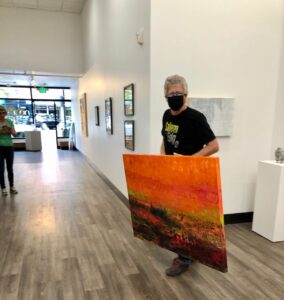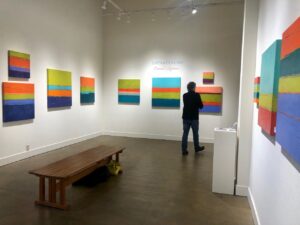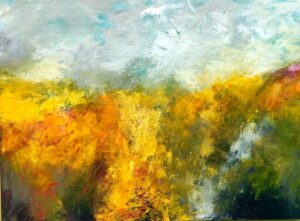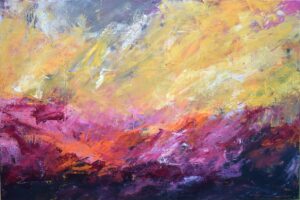I am pleased to offer an article written by guest Howard Collins. Howard is my spouse of 49 years and for the past year, the business manager for my art practice. Howard is my number one fan and his taste in art has evolved through the years, which prompted him to write this article for my blog.

“Ugh.” “I don’t get it.” “That’s weird.” “What’s the point?”
These words have admittedly come from me about abstract art.
My gradual transformation into appreciating and loving abstract works has taken time. Unlike the acquired taste for kombucha, which took real effort and perseverance, coming to love abstract art was more evolutionary than effort.

My early years of art appreciation was not as a result of education. It was more akin to “Me like, pretty,” when I saw something that caught my eye. But art has always been important to me regardless of my ignorance. My eye was attracted to precision, to realism, to clarity, and realistic portraits. In walking through museums, I was attracted to and spent as much time as I could looking at the details by various master artists. I always gave a short glance at modern, contemporary, and abstract art, but never much time and clearly little thought.
However, I subtly found myself spending more time looking at impressionist art and less realistic works. Monet blew me away. Here was realism without precision and detail, but beautiful nonetheless. This was a style of art without precision, but collectively, the strokes created beautiful compositions. My eyes began to look at the art of other impressionists and marvel at their beauty. Without warning I began to spend even more time looking at non representational art. My world of art appreciation exploded.

Dayna’s taste in art has always differed from mine. I began to look closer at pieces and artists to whom she was attracted. It stretched me to look at works that I previously would only glance at and rarely see. Vertical and horizontal colorful lines, unusual compositions, and figures in ways that had usually left me cold, now drew me in.

Modern art, cubism, angles, distorted figures all called me to view them in a way I had not felt before. I found Pollock, Kandinski and de Kooning, and a renewed interest in Picasso.
And therein lies the difference for me. I felt the art. An emotional response rather than mere appreciation of the art. Feeling what the piece was sharing with me, allowing the piece to talk to me. This was a moving experience and was totally unlike viewing realistic works. As strange as it sounds, listening as a piece talks to you is quite normal. Explaining how this works for me is difficult, but it is real. For me works of art talk to me through their composition, arrangement, color and form, which cause an emotional response in me.
My eye views abstract art and its perceived disorganization in different ways. At times I seek to make sense of the abstract lines, shadows and colors by seeing what I can see. At times I take in the whole of the abstract and free myself from my realism tendency; and then at other times, I pick a small portion to see what I can see and hear from the art. If I bring an attitude of openness, it allows the painting to express itself and for my eyes, brain, and emotions to react.

I have to interject a side story here. We recently talked to the maintenance engineer at The Dundee Hotel. I told him Dayna was the artist of many of the works hanging there and his eyes lit up. “Did you do the pieces in the conference room?” he asked Dayna. “Yes,” was her reply and he said: “I have questions for you. I’ve studied them.” We walked to the three painting and he wanted to know if the images he saw in them were intentional. He saw birds, a cow, and other animals throughout her works. Dayna laughed and said “Don’t show me, I’ll never be able to not see them.”

He was astounded to hear that Dayna had not intentionally included farm animals in her abstracts. He was trying to make sense of the abstract work though his interpretation of what he saw. By the way, he loved the works and his appreciation came from their composition and his interpretation, and not by the intention of the artist.
In my wasted youth, I thought Picasso was odd, irrelevant, and not really worth looking at. Even today not all of his pieces move me, but many do in a way I would never have thought possible. His humor is outstanding. I stood before a Picasso series created during the last months of WWII and I was laughing. They were optimistic, playful, joyful and irreverent. Yes, I was the only one laughing, but that’s me. They were simply magnificent.
Then there is the power of abstract. There is power in the stroke, texture, form, composition, and message. With or without a representational image, abstract work speaks and conveys a message. In part, the power comes from eliminating a common scene or picture for our minds to see. We are engaged to interact with the artists’ work. Just as letting our children play in a dusty pile of dirt, they create games, form roads, and valleys in their minds, which they translate into the dirt pile; just as we get to create from abstract art.

Amazingly, the power of abstract art endures beyond a single viewing but continues over time and changes as we see different elements as we change. A piece of Dayna’s work, Singed by Fire and Light, hung in my office for three years until I moved my office home. Every day this piece spoke to me, every day it gave me something. Sometimes it spoke to me as a whole, drawing me deep inside; sometimes from a small section, sometimes from hints of color revealed from the sunlight pouring in the window. I miss this piece terribly. It now hangs beautifully at The Dundee Hotel, where I am writing this piece and I’ve literally hugged it.

I still appreciate and enjoy realism and impressionism. But abstract art, with a big thank you to my wife, attracts me, speaks to me and fills me.
Artists Dayna admires:
Joan Mitchell, Helen Frankenthaler, Lee Krasner, Elaine deKooning, Cy Twombly, Robert Motherwell, Robert Diebenkorn

Artists I admire:
Mark Rothko, Willem deKooning , Jackson Pollock, Picasso, Kandinski, Dayna Collins
